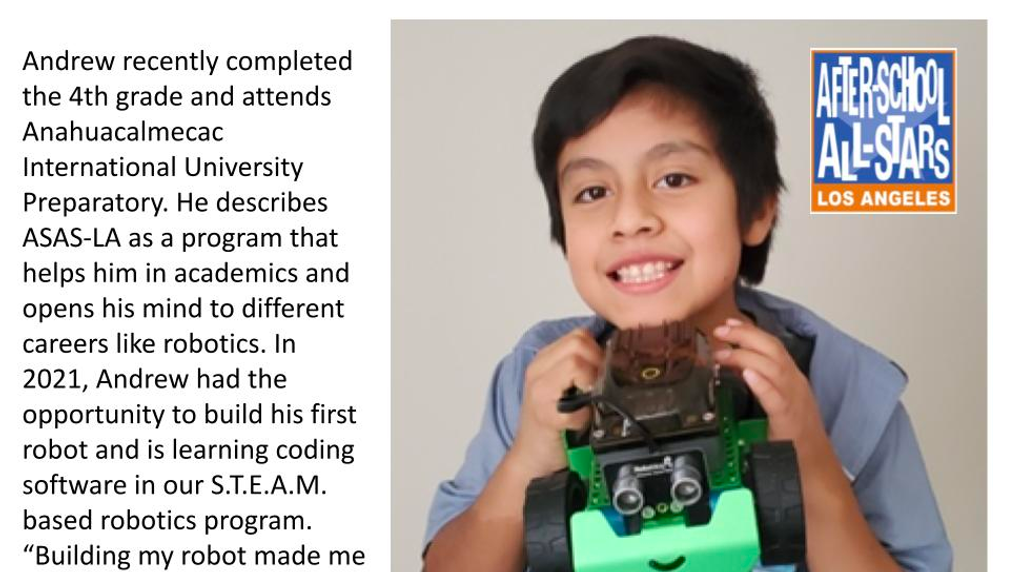ASAS-LA Coding Lab and Robotics Program for Youth
The purpose of the program is to provide underserved youth with access to STEAM based enrichment programming that builds fundamental coding skills; offers opportunities to use those skills to successfully complete robotics, engineering and web design projects; and participate in the annual Beyond Science Fair. It will also expose approximately 300 K-12 students (of whom 98% are youth of color and 92% are economically disadvantaged) to college and career opportunities in STEAM fields.

What is the primary issue area that your application will impact?
K-12 STEAM Education
In which areas of Los Angeles will you be directly working?
Central LA
East LA
San Gabriel Valley
San Fernando Valley
South LA
City of Los Angeles
In what stage of innovation is this project, program, or initiative?
Expand existing project, program, or initiative
What is your understanding of the issue that you are seeking to address?
A major challenge facing communities across the nation is a shortage of qualified professionals in STEAM industries. Furthermore, there is a significant underrepresentation of African-Americans and Latinos in STEAM industries with minorities making up only 9% of college graduates working in science and engineering. African-Americans make up 11% of the U.S. workforce overall but represent 9% of STEM workers, while Hispanics comprise 16% of the U.S. workforce but only 7% of all STEM workers. The situation for women is also concerning as women who majored in computer science or related computer fields are less likely than men trained in those fields to be working in computer jobs. A recent ASAS-LA survey of STEAM based after-school programs concluded that there are virtually no other coding and robotics programs within a five-mile radius of our partner school sites. This barrier to access makes it very difficult for students who demonstrate an aptitude for STEAM to develop their skills.
Describe the project, program, or initiative this grant will support to address the issue.
The ASAS-LA Coding Lab and Robotics program will provide approximately 300 students at 15 Los Angeles school sites with deeper STEAM knowledge and experience around coding, robotics, web design and STEAM career exploration. This program builds on the recent progress of existing programs focused on providing students with coding skills utilizing the Kids Code and 9 Dots curriculum. Students used the Pixel Art, Coding from Scratch, and Coding IRL modules. The Coding Lab and Robotics Program expands and institutionalizes our current coding and robotics engineering programs by implementing a weekly Coding Lab that further develops students’ coding skills at 15 additional schools including Middle Schools and High Schools. The program provides students who have identified STEM as a major academic and enrichment interest with 4 hours (144 hours per school year) of weekly coding lessons which are specifically designed to carry students from a beginner level to an intermediate level, and on through to an advanced level when they are ready. They will then have the opportunity to apply their skills to robotics activities and acquire their own personal Q-Scout Robot. After successfully programming their robot, they will have opportunities to showcase their completed projects.
Describe how Los Angeles County will be different if your work is successful.
Our vision for success for this program is to address students’ needs and support the increase of African Americans, Latinos, and women in post-secondary STEAM degree programs and in STEAM industries. ASAS-LA will positively impact the youth of Los Angeles by implementing its Coding Lab and Robotics Program completely free of charge for youth and their families and strive to eliminate disparities in access to STEAM fields that exist between students from low-income backgrounds and their more affluent peers. In response to the nationwide need to increase ASAS-LA's students’ access to STEAM based programs, we embed STEAM learning into all of our program areas. This approach ensures that all 14,000 students across the 59 schools served experience STEAM based learning at some measurable level. STEAM projects are relatable to students’ lives outside of school but are also rooted in STEAM concepts allowing our students to learn while creating something that is relevant to them.
What evidence do you have that this project, program, or initiative is or will be successful, and how will you define and measure success?
For over ten years, ASAS-LA has conducted student success and program evaluations in partnership with the Claremont Evaluation Center (CEC) at Claremont Graduate University (CGU). The CEC analyzes the program data from multiple data sources, enabling us to draw conclusions, make necessary corrections, and develop short and long-term advancement strategies. These evaluations examine relationships among program dosage; program quality; academic outcomes; social emotional outcomes of participants; school attendance; student, parent and teacher/administrator satisfaction. CGU conducts focus groups, administers surveys, and holds planning sessions with staff to reflect on evaluation data and engage in continuous quality improvement. ASAS-LA also collects grades, test scores, attendance, homework completion, and in-school behavior for program participants. These data points are then used in formal program design, planning sessions, and staff training.
Approximately how many people will be impacted by this project, program, or initiative?
Direct Impact: 315
Indirect Impact: 1,000